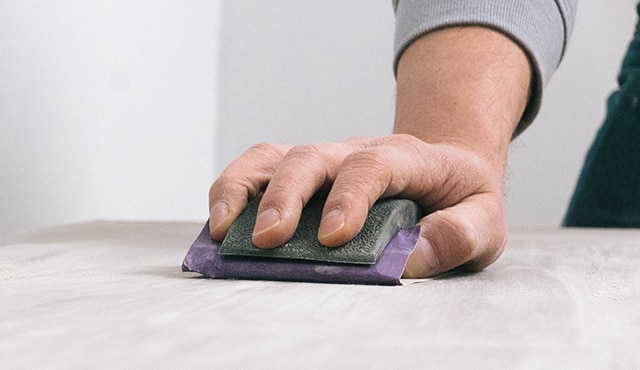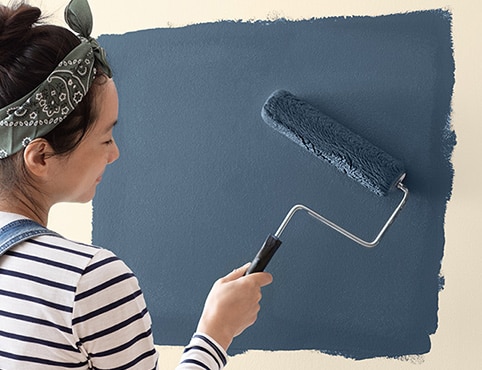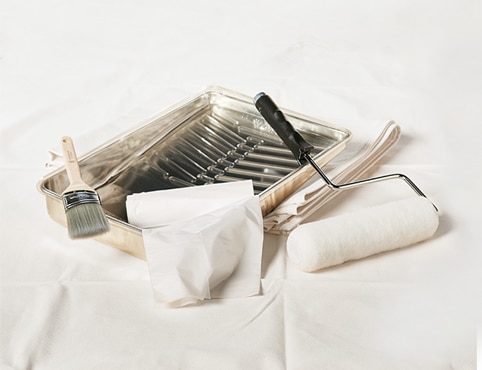To Sand or Not to Sand?
Sanding is not always necessary for every painting project. Here are a few painting scenarios for which we highly recommend sanding:
- Bare substrates, especially wood, that have not been previously painted or stained
- Previously painted surfaces with peeling paint or damage
- Metal surfaces with the presence of rust
- Any areas where you’ve made repairs, including fixing cracks and small holes in drywall
- Previously painted surfaces with a high-gloss finish
Key Watchout
When it comes to sanding, remember three words: clean, dry, dull. Always make sure you clean the surface before sanding and allow it to dry fully.The goal of sanding for most painting projects is to dull the surface. Dulling is especially important when you’re working with a previously painted substrate that has a high-gloss coating. If you don’t sand, you could face adhesion problems when it comes time to paint.
Sandpaper Grit and Why It’s Important
Choosing the right grit level for your project needs is important to achieving optimal adhesion and a smooth finish.
- All sandpaper has a grit level, which ranges from coarse to fine.
- The higher the grit number, the smaller the grains, and the finer the grit.
- The lower the grit number, the larger the grains, and the coarser the grit.
- If your sandpaper is too coarse, it could damage the surface of your project.
- If your sandpaper is too fine, it could take longer than necessary to achieve a smooth surface ready for painting or staining.
- Using a coarser grit can speed up the sanding process, but can damage the surface, and might require a second pass with a fine-grit sandpaper.
- See our sandpaper grit chart below to help you choose the right sandpaper.
Key Watchout
Some projects call for multiple sandpaper grits. If you’re tackling a project that requires multiple rounds of sanding, start with a coarse-grit product, then switch to fine-grit sandpaper for a smooth finish.|
Type |
Coarse |
Medium |
Fine |
|
Grit Number |
40 to 80 |
100 to 150 |
180 to 220+ |
|
Usage |
|
|
|
|
Type |
Coarse |
Medium |
Fine |
|
Grit Number |
40 to 80 |
100 to 150 |
180 to 220+ |
|
Usage |
|
|
|
Grit Number: 40 to 80
Usage:
- The best sandpaper for opening the grain of wood to accept stain, polyurethane, or paint, or for sanding hard metal like steel and concrete.
- This grit level can also be used for taking off multiple coats of paint or any varnish that is difficult to remove.
Type: Medium
Grit Number: 100 to 150
Usage:
- Use for dulling a previously painted surface with only a coat or two of paint
- Good for removing any marks you might have made on wood to plan out your project
- Good for sanding laminate
Type: Fine
Grit Number: 180 to 220+
Usage:
- Best for smoothing a surface in between coats of paint
- Good for making a final sanding pass over wood or metal that has been previously sanded with a lower grit sandpaper.
- A great sandpaper choice for softer metals, like aluminum.
What About Sanding Tools?
- For most DIY painting projects, a hand-held sanding sponge or block would be sufficient.
- If you want to get the job done faster, a palm or orbital sander tool would help.
- To sand floors, consider power tools like a belt or floor sander. These are professional-grade tools, so consider hiring a professional.
Always make sure you have proper training on any power tools you use. Not sure if you need power tools to sand, or have other questions? Visit your locally owned Benjamin Moore store for expert help.
Sanding Tips for Painting Projects
Now that you’ve picked the best sandpaper and sanding tool for your painting project, here are a few best practices for sanding.
- If you’re sanding wood, always sand with the grain, not against it.
- Beware of over-sanding, especially with higher-grit sandpaper, as you could lose adhesion.
- Consider what kind of paint you’re using after you sand. For example, if you’re using a clear finish, like Stays Clear®, you’ll want to sand down any imperfections and be sure not to scratch or damage the surface by over-sanding. If you’re painting with a more opaque finish coat, you don’t have to be as precise.
- When it comes to exterior wood projects, if you’re using a clear top coat, like Woodluxe® Translucent Exterior Stain, it’s important to sand down any imperfections as well before applying your finish coat.
- Sanding is a best practice for painting projects using acrylic and alkyd paints, as well as stains.
Helpful Tip
Should You Sand Between Coats of Paint?
The end-goal for painting projects is to produce a very smooth finish: One way to achieve this is to lightly sand between each coat of primer and paint you apply using fine-grit sandpaper.Sanding between each coat of primer and paint is one way to achieve the best finish for any painting project.





